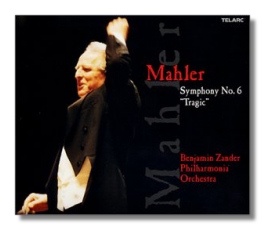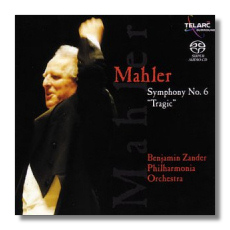
The Internet's Premier Classical Music Source
Related Links
- Mahler Reviews
- Latest Reviews
- More Reviews
-
By Composer
-
Collections
DVD & Blu-ray
Books
Concert Reviews
Articles/Interviews
Software
Audio
Search Amazon
Recommended Links
Site News
 CD Review
CD Review
Gustav Mahler

Symphony #6 "Tragic"
With alternative version of finale,
plus a bonus discussion disc
Philharmonia Orchestra/Benjamin Zander
Telarc CD-80586 DDD 3CDs: 54:27, 64:26, 79:43
Also released on Hybrid Multichannel SACD SACD-60586
Amazon
- UK
- Germany
- Canada
- France
- Japan
- ArkivMusic
- CD Universe
Zander's Mahler series for Telarc continues with its most impressive entry yet – a Sixth Symphony of telling detail and powerful overall impact. This comes as no surprise, as Zander's previous recording of this work – with the Boston Philharmonic Orchestra – has been praised to the skies, and deservedly so. Since that live 1994 recording (available on Carlton Classics), Zander's attachment to and understanding of the score has grown, and now that he has recorded the work with the Philharmonia – not that the Boston Philharmonic disgraced itself in any way – what we have here is as close to a definitive recording of this symphony as we are likely to hear. As if additional incentive were needed, Telarc has sweetened the deal by including a third "bonus" CD of Zander discussing the work. This is "music appreciation" at its best – enthusiastic, insightful, and completely lacking in condescension. Zander is more than a great conductor; he's a great teacher as well.
Unlike many conductors, Zander includes the third hammer-blow in the Finale, even though Mahler excised it. He argues that Mahler the composer was dramatically and musically correct in putting it there in the first place, even though Mahler the performer might not have been able to deal with the emotional implications of what could be, symbolically, his own death set to music. For listeners who don't agree with the conductor, Zander has thoughtfully provided them with a second recording of the Finale – this time, without the third hammer-blow, and with Mahler's lightened orchestration at that point in the score. (And the three hammer-blows are the most effective ever recorded – truly horrible and annihilating. To create them, a wooden box was built to Zander's specifications, and it was struck by a plumber's mallet.) Also, Zander places the Scherzo before the Andante moderato – not so unusual a decision, but not universally accepted, either. Zander argues that the back-to-back A-minor horror of the opening movement and the Scherzo might have intimidated Mahler the performer. The conductor justifies his decision by examining the key relationships among the movements. If the A-minor Scherzo is played as the third movement, the modulation that occurs right at the start of the Finale is harmonically unnecessary. If the third movement is the E Flat Major-major Andante moderato, then the Finale's opening modulation makes sense.
From the preceding, it should be clear that Zander has taken considerable pains over this score. While nothing has been left to chance, the music-making on this recording never feels calculated. Through phrasing, sensitivity to dynamics, apt tempos and tempo relationships, and finely judged orchestral balances, Zander has come up with a Mahler Sixth that is immediate and intensely communicative. It is a long, sometimes disturbing, but always exhilarating look into Mahler's soul.
The Philharmonia Orchestra plays gloriously throughout, and Telarc's engineers have balanced idealism and realism to produce sonics that serve the music to perfection. The recording was made in the Watford Colosseum in Watford, England during May 2001.
An essential recording for anyone who loves Mahler or who wants to know him better.
Copyright © 2002, Raymond Tuttle





















